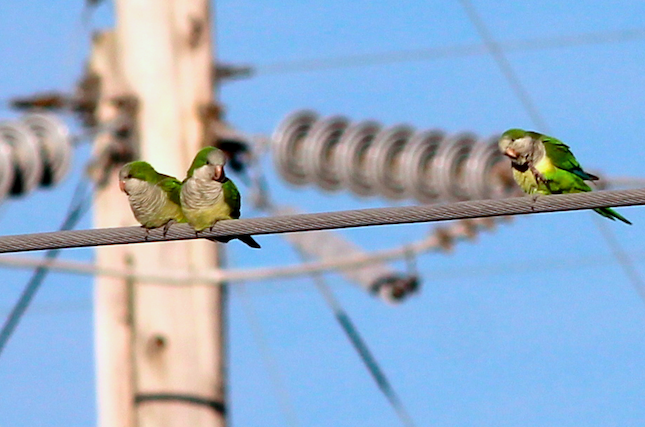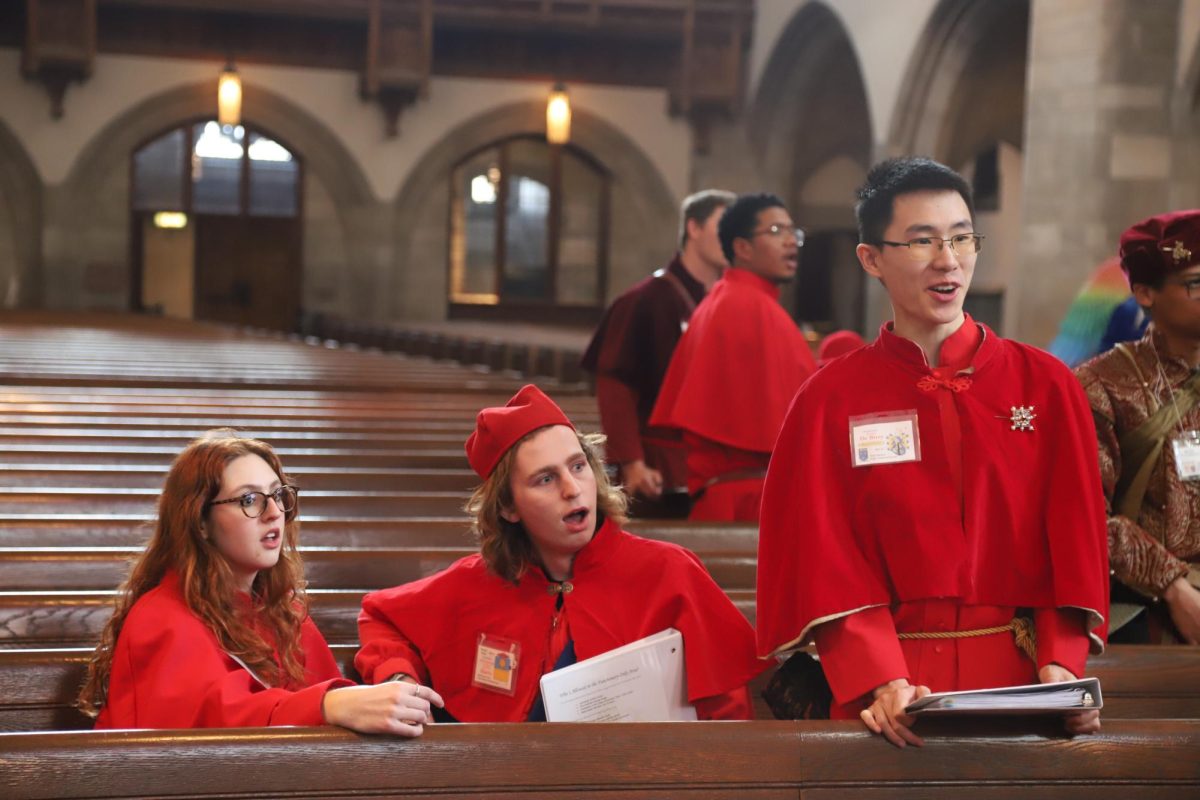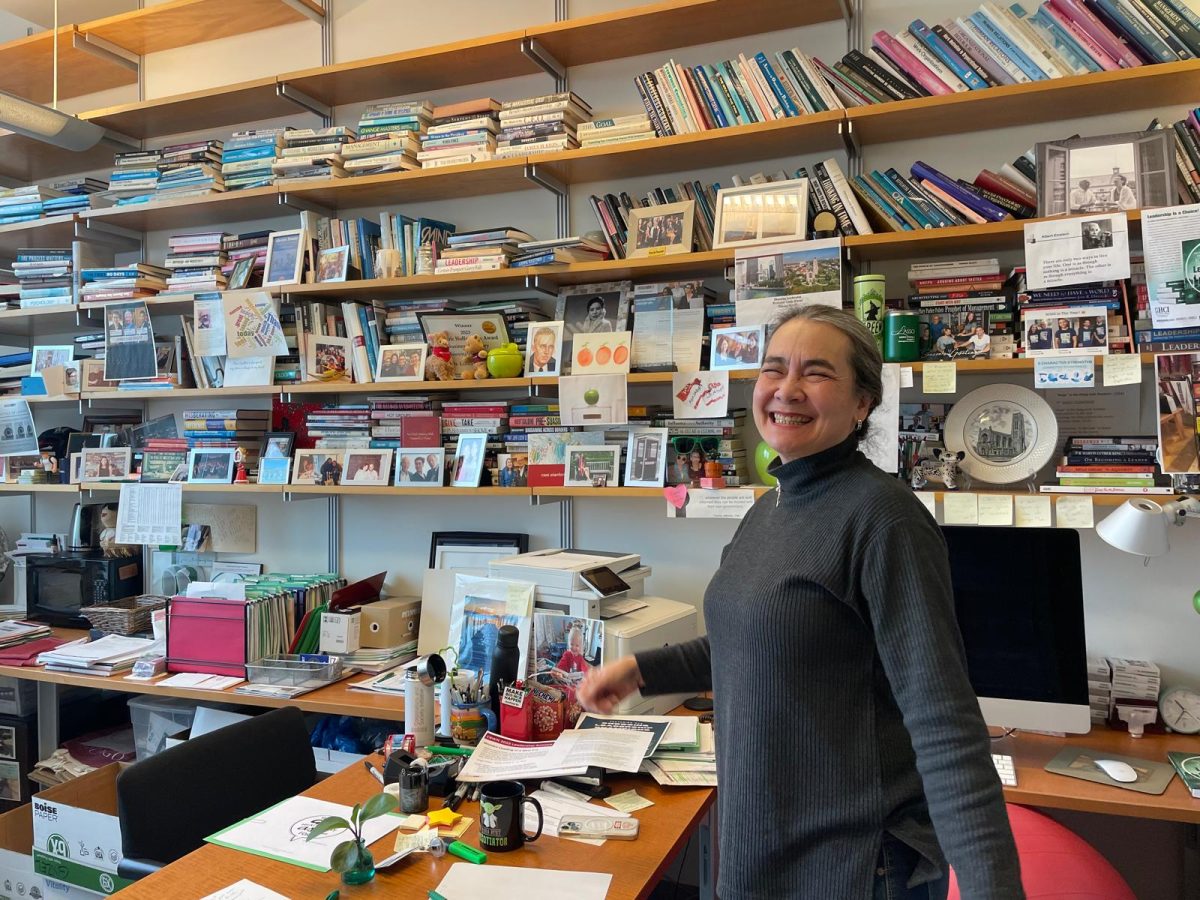It happens to you slowly. You might find yourself waking before dawn, a period of a Sunday morning that really ought never to be witnessed, and catching the 6:30 a.m. bus headed somewhere. Blink, and you’re crouched in the shrubs underneath the Chicago Skyway, just before the exit to Indianapolis Boulevard, peering up into the rafters at a pile of sticks. Ideally, the day is breaking, the air still dewy and quiet. It’s just when your neck has started to ache that you might spot one emerging from its nest, a blurry speck of lime green without your glasses: a monk parakeet, wild and free.
The most striking feature of Chicago’s monk parakeets is their utter unbelonging. These are subtropical parrots that have absolutely no right to be thriving in this wind tunnel of a city, this town known for its hostile winters. Yet here they are, 10 inches long and right at home, the most adorable middle fingers to extractivism and wildlife trafficking you’ve ever seen.
The precise origins of the city’s monk parakeet population remain something of a mystery to the ecologists that study them. Scientists know that they were among the thousands of birds transported here on cargo ships from their homelands in South America in the middle of the last century. But regarding whether the members of the original urban cohort were deliberately released by aggravated owners or escaped of their own volition, we can only speculate.

Having lived with a parrot for many years—the infamous Kuku, who was grafted onto the Gersony family tree when the neighbor we were bird-sitting for “forgot” to pick him up—I find the former explanation plausible. One too many squawks at 7 a.m. on a Saturday morning can make release a tempting prospect. But I prefer the second explanation. I picture the escapee as my very own Kuku, wearing sunglasses and a trench coat, slipping out through a North Side dog door in the dead of night. He’s a vagabond finding freedom in the big city, flapping through alleyways, tucking his wings behind telephone poles to avoid roving searchlights. Perhaps he’s following a drinking gourd, or he’s just your standard forty-niner, drawn by an instinct either liberatory or delusional to that nook below the Skyway.
One of the main reasons why parrots have piqued the settler American interest is that they are “exotic.” Rigorously defined, this means that they are never more than one or two more generations separated from their wild ancestors. In casual usage, the term refers to a world Americans haven’t bothered to learn about.
Researchers have found that the more domesticated a bird is, the less able and motivated it will be to escape. Perhaps, then, it was the parakeets’ wildness—the pretext for their subjugation—that tipped the scales of their destiny toward freedom.
* * *
The parakeets’ history in Chicago is well-documented in a recently published anthology, Naturalized Parrots of the World, edited by the University of Chicago ecologist Stephen Pruett-Jones. The first monk parakeet was spotted in Hyde Park in the late ’70s, at which point their local population started to double every three years. Knowing Chicago politics to be a game of hardball, these early settlers nested across the street from then-mayor Harold Washington, who became enamored with the birds. After his death, when the Department of Agriculture called for the city’s monk parakeets to be removed, a group of Washington’s devotees threatened a lawsuit. And so the birds remained.
Ecologists believe that there are two main reasons why monk parakeets have been so successful in urban environments. The first is that they have an extraordinary ability to make themselves at home. Unlike many other parrots, monk parakeets build their own nests, rather than furnishing existing holes. For this reason, the birds have been known to set up camp in odd places, from electrical wires to skyscrapers.
The second reason for the urban success of monk parakeets is that they can and will eat anything vegetarian. According to the anthology, their diet consists of “whatever is available.” Nuts, berries, leaves. They don’t discriminate.

Lest we give them too much credit, however, the city’s monk parakeet population is kept alive only by the good graces of strangers. The current scientific consensus is that in winter, they subsist primarily on backyard bird feeders. Large flocks have been spotted going from house to house in Chicago’s Portage Park neighborhood. It’s a familiar pattern: swarm, devour, exit.
In Naturalized Parrots, Pruett-Jones writes that parrots are “the most human of birds”: They typically form lifelong monogamous relationships, show an enthusiasm for play all their lives, and lock beaks to show affection. He omits from this list their unfailing cunning and opportunism. Innocent though they may appear, monk parakeets can become an agricultural “pest,” the technical term for a species that gets in humanity’s way. They are ill-reputed in their native countries for descending upon crops of corn or sunflowers and eating up every last bit. In the 15th century, Incas stationed guards next to cornfields, armed with noise-making devices specifically designed to scare the birds away. If they could, I have no doubt that monk parakeets would be acidifying the ocean right along with us, commodifying their only home, and violently capturing as pets animals whose intelligence they aren’t able to recognize.
En masse, monk parakeets are a force to be reckoned with. One of Pruett-Jones’s publications describes how, in 2001, a colony nesting in Florida’s electrical lines caused over 10,000 power outages in the state’s fossil fuel-fired energy grid. Florida officials thanked them for this brave feat of climate activism by trying to scare them out of their own nests with owl dummies. The parakeets, needless to say, were not fooled.
Nevertheless, the article continues, “despite these negative impacts of monk parakeets, there are increasing efforts by people to protect them.” New York and New Jersey’s state legislatures have made it illegal to capture or harm a monk parakeet living in the wild.
In his short story, “The Great Silence,” the science fiction author Ted Chiang writes from the perspective of a Puerto Rican parrot. The narrator laments the irony of astronomers’ attempts to listen for signs of extraterrestrial intelligence, tilting massive receptors up into the cosmos. Extra-human intelligence already exists on Earth, the parrot explains; we’ve been here all along.
* * *
I have a vegan friend who regularly experiences fits of moral discomfort over the well-being of his pets. A philosophy major if there ever was one, Yair owns two fish, Fin and Scale, rescues originally purchased as “feeder fish” for another friend’s turtle.
When Fin and Scale came into Yair’s possession this summer, he housed them in a tank that sits atop a bookshelf in his Hyde Park apartment. This provoked in him a great deal of rumination. If the fish are happy in their tank, he’s acted in accordance with hedonistic utilitarianism, the ethical theory he espouses. But it seemed not out of the question that the life he had constructed for Fin and Scale amounted to nothing short of a living hell. Under these circumstances, Yair tells me, the mandate for any self-respecting hedonistic utilitarian would be clear: put them out of their misery.
After months of deliberation, Yair has arrived at a fragile peace. Because the fish were bred for captivity, he reasons that the best thing to do is keep them in their tank and care for them well. This conclusion also has the benefit of being logistically convenient, as he is unsure he has the stomach to commit cold-blooded murder. He still believes there’s a chance that Fin and Scale live in a state of perpetual agony. But he’s pegged the odds of this as not much more than 30 percent. These are odds Yair can live with.
I once met another philosophy student who bought a tank of tiny red shrimp during the early stages of the COVID-19 pandemic. The shrimp live in a self-sustaining ecosystem; one only needs to place the jar in sunlight, which feeds the algae, which feeds the shrimp, which excrete nutrients, which feed the algae. Their owner maintains that this is the only “authentic” relationship with an extra-human life form she’s ever been in, because it’s a relationship of equals in which neither party is existentially dependent on the other. She’s cheered by the possibility that the shrimp might not know she exists at all.
Parrots can’t match tiny red shrimp in this regard. But they certainly have more chutzpah than anything that swims in a jar. No bigger than a coffee cup, Kuku is far and away the spunkiest, most fearsome creature I’ve ever known. We used to call it “dive-bombing,” the way he would attack strangers: a blur of motion and feathers streaking across the kitchen to defend us against any visitor to the house, screeching ferociously, claws and sharp beak aimed at their scalp. Even if we remembered to lock him in his cage when company arrived, he’d make his aggression known, maintaining beady eye contact with the visitor while shaking the bars of his cage with his beak. It’s an action that translates—and I am absolutely certain of this—to “come at me, bro.”
But Kuku loves as fiercely as he dive-bombs. As soon as our guests disappeared, his beak became a delicate instrument of affection, smooth keratin wandering stepwise across our skin with the tender attention that only love can elicit. I used to curl up reading a book on the couch while Kuku gently combed each of the fine hairs on the back of my neck. In exchange, we can offer him our mammalian warmth: He loves to snuggle into the nook below a person’s chin, bliss for his cool, lean body. It’s a sight that creates pangs of homesickness when I FaceTime my dad from halfway across the country. I often catch them watching reruns together, Kuku wriggled under my father’s sweater vests—those offensively argyle pullovers they stopped selling in 1960—a happy, chirping lump below the wool.
Birds have always softened my father, the son of Holocaust refugees. Robert Gersony made his career as a field worker for the U.S. State Department, gathering information during and after some of the most gruesome events of this century. His approach, unprecedented in the department’s history, was to interview hundreds of ordinary people who had survived these atrocities. He’d spend months alongside refugees, eating one meal a day and regularly working himself to the point of physical and mental breakdown.
Now, he relishes his hard-earned retirement: He catches up with old friends, relaxes, and “attends to legal matters” with Kuku (which is to say, watches Judge Judy on his ancient, decidedly three-dimensional TV). He has also doubled down on his efforts to put food out for birds. He does this with the same degree of earnestness and care that I remember from my own childhood. A creature of insurance, my father keeps our hallway closet stocked with a quantity of bird seed that I suspect will feed our family for the first month or two of the climate apocalypse. Every few weeks, he lugs a 20-pound sack of these rations to the sunny book-filled room we call the library. He pours sunflower seeds into the tall, lighthouse-shaped feeder and wedges sticky cakes of suet into a birdhouse—for woodpeckers, he explains. Then, in an act of athleticism I now understand is astounding for his age, he sticks himself halfway out the window and hangs the delicacies on hooks that extend from our home’s brick wall.
Exertions completed, he sits back in the leather chair by the window and rests, sun on his face, a smile wrinkling his friendly eyes, watching as the birds gradually take notice. How overjoyed my father would be to be visited by a flock of monk parakeets during a Chicago winter.
Deep in an Internet rabbit hole, I learned that nearly 70 species of birds in our home state of Virginia are at risk of extinction due to climate change. Poring over mug shots of the endangered, I recognized several of them as regular visitors to my father’s feeder.
A surprising amount of the literature on naturalized parrots is devoted not to the birds themselves, but to the way people respond to them. “People are seldom ‘neutral’ as regards monk parakeets,” reads one of Pruett-Jones’s papers, in an endearingly scientific tone. One study in the anthology looked at public attitudes towards the birds across Europe. “Parisians who had private green spaces or balconies were more likely to have reservations about or dislike parakeets,” it concludes. Other findings hit deeper. “If a rare and interesting animal is encountered with increasing frequency, it can become common and banal.” A single parakeet is a symbol of conquest—a flirtation with an exotic, resource-rich world. A flock of them is a nuisance. We prefer them alone and caged.
Isolated from their peers, parrots have been known to develop depression and die.
* * *
With a self-seriousness that I’m sure is naive, I feel sometimes that my whole life has been spent discovering and rediscovering a Buddhist proverb, in different shades and species of truth: that understanding is love’s other name. This is what the leader of Tuesday meditation told me last summer when I confessed to the group over Zoom that my dad and I couldn’t stop fighting. As you notice frustration blooming, she suggested, try to summon careful attention alongside it. Can you see in him your own small, suffering self, innocent and seeking comfort?
Training this careful attention on Kuku over the years, one can detect a birdy thought process emerging from his strangeness. With time, his idiosyncrasies become familiar, even reasonable. Grinding his beak is his way of requesting food while on a person’s shoulder. The seemingly random squawking fits occur when he spots a squirrel out the window, often too far for a human to see. And his casual destruction of household objects is no more than our shared creaturely desire to make a home: in my sweater, in the couch’s stuffing, and (to my parents’ halfhearted protests) in the wallpaper.
Watching Kuku’s long-lost cousins under the Skyway, I was seized with the mutually affirming sensations of joy and recognition. These birds are Kuku in another, freer life: These are fierce beings that my own species tried, but failed, to reduce to exotic objects. What is their naturalization in Chicago but a victory, a protest of the ethos of extraction that brought them here? Unwittingly at first, but now wholeheartedly, I’ve started rooting for them.
Just as quickly as monk parakeets arrived in Hyde Park, they began to leave. Their population started to decline in 2005, both in the neighborhood and nationwide. Local ecologists think this is when their colonies split and spread to other parts of the city. It’s an impulse I sympathize with—hitting the road, once again, in search of a better life—though I read these studies with an unexpected pang of sadness.
Pruett-Jones can tell the rest of the story.
“After 2015,” he wrote, “the population of Monk Parakeets in Chicago and in the nation stabilized, but it has not yet begun to increase to numbers seen before the decline. In Chicago, Monk Parakeets still persist and survive but in smaller numbers.
“The population in Hyde Park is more or less extinct, though there are hundreds of birds still nesting in the greater Chicago region. But why the birds left Hyde Park remains a mystery.”










Chris A / May 30, 2024 at 5:21 pm
Looking at one in my yard now. Southwest suburb of Chicago. Hope it eats cicadas.
Greg / May 27, 2024 at 10:03 am
I would believe they were there at least a decade earlier. I grew up in Blue Island and my Father drove the family to see the parrots. This would have been sometime in the 60s.
ExDC / May 18, 2024 at 3:36 pm
First saw a monk parrot in HP in 1978 at 53rd and HPBlvd (of course). I think they left because a) a bunch of the huge pre-settlement oak and elm trees that could accommodate their 4 to 6 foot long nests came down in a series of storms in the 1990’s and 2000’s and on, and b) ComEd repeatedly and aggressively removed their nests from the warm electrical transformers that they also liked to build around. I miss the raucous rumbles between the parrots and their archenemies, the crows, who tried to control the same open spaces.
sjm / Feb 24, 2024 at 11:50 am
They missed Harold of course!